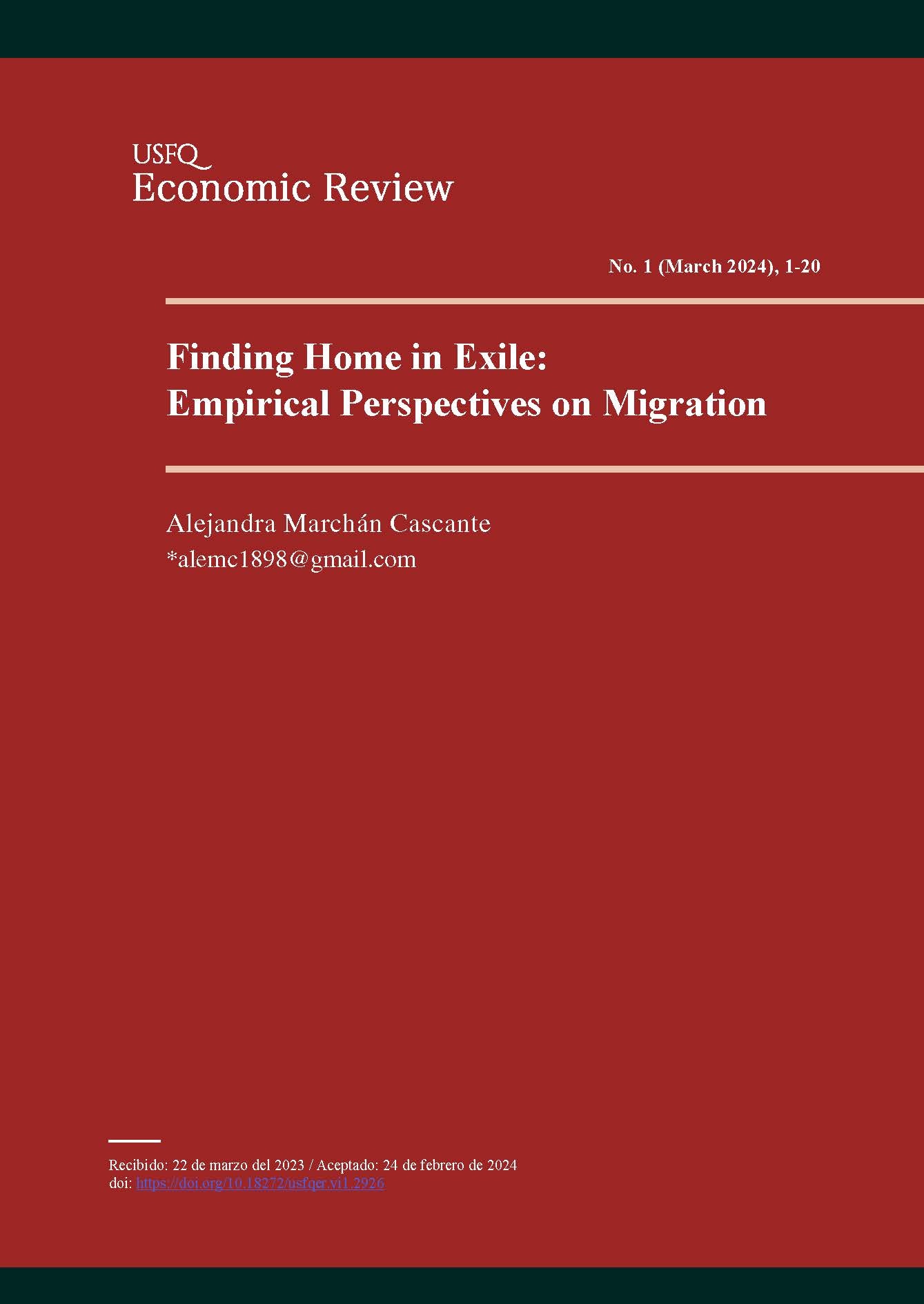Finding Home in Exile: Empirical Perspectives on Migration
Keywords:
International migration, Economic development, cross-sectional modelsAbstract
The effect of national indicators on the International Migrant Stock is studied to determine policy-relevant conclusions to better manage migrant flows. Through a cross-sectional model estimated through ordinary least squares with country-level data from 2015 it is found that higher GDP, less restrictions to business creation, more culture diversity and less corruption are associated
to higher migration. Democracy is a significant covariate but is negatively correlated with migrant flows, which is counterintuitive. Through more flexible functional forms, it is discovered that countries located in Middle East and North Africa, where most rich oil-exporting countries are located, have higher migration flows yet lower democracy scores, which might be influencing the sign of the democracy effect. When analyzing democracy in the Western Hemisphere, it is found that the effect is positive for relatively richer countries in terms of GDP.
Downloads
References
Abel, A. B., Bernanke, B. S., & Croushore, D. (2014). Macroeconomics (8th ed.). Pearson.
Anderson, J. E. (2011). The Gravity Model. Annual Review of Economics, 3(1), 133–160. https://doi.org/10.1146/annurev-economics-111809-125114
Azad, K. (2020). The Effect of Democracy on Migration: A Panel Data Approach (MPRA Working Paper No 105058), University Library of Munich, Germany. https://mpra.ub.uni-muenchen.de/105058/1/MPRA_paper_105058.pdf
Beine, M., Bertoli, S., & Fernández–Huertas Moraga, J. (2016). A Practitioners’ Guide to Gravity Models of International Migration. The World Economy, 39(4), 496–512. https://doi.org/10.1111/twec.12265
Bertoli, S., & Fernández-Huertas Moraga, J. (2013). Multilateral resistance to migration. Journal of Development Economics, 102, 79–100. https://doi.org/10.1016/j.jdeveco.2012.12.001
Bodvarsson, O. B., Simpson, N. B., & Sparber, C. (2015). Migration Theory. In B. R. Chiswick & W. P. Miller (Eds.), Handbook of The Economics of International Migration (pp. 4–46). North-Holland
Borjas, G. J. (1987). Immigrants, Minorities, and Labor Market Competition. Industrial and Labor Relations Review, 40(3), 382. https://doi.org/10.2307/2523494
Borjas, G. J. (1999). The Economic Analysis of Immigration. In O. Ashenfelter & D. E. Card (Eds.), Handbook of labor economics (pp. 1697–1760). Amsterdam; New York: North-Holland; New York, N.Y., U.S.A. : Sole distributors for the U.S.A. and Canada, Elsevier Science Pub. Co
Borjas, G. J. (2003). The Labor Demand Curve is Downward Sloping: Reexamining the Impact of Immigration on the Labor Market. The Quarterly Journal of Economics, 118(4), 1335–1374. https://doi.org/10.1162/003355303322552810
Cameron, L. A., Erkal, N., Gangadharan, L., & Zhang, M. (2012). Cultural Integration: Experimental Evidence of Changes in Immigrants’ Preferences: IZA Discussion Papers. https://ideas.repec.org/p/iza/izadps/dp6467.html
Caragliu, A., Del Bo, C., De Groot, H. L. F., & Linders, G.-J. M. (2012). Cultural Determinants of Migration. The Annals of Regional Science, (51), 7–32. https://link.springer.com/article/10.1007/s00168-012-0531-3
Card, D. (1990). The Impact of the Mariel Boatlift on the Miami Labor Market. Industrial and Labor Relations Review, 43(2), 245. https://doi.org/10.2307/2523702
Card, D. (2001). Immigrant Inflows, Native Outflows, and the Local Labor Market Impacts of Higher Immigration. Journal of Labor Economics, 19(1), 22–64. https://doi.org/10.1086/209979
Chiswick, B. R., & Miller, W. P. (Eds.). (2015). Handbook of The Economics of International Migration: Volume 1A: The Immigrants (1st ed., Vol. 1A). North-Holland.
Dimant, E., Krieger, T., & Meierrieks, D. (2013). The effect of corruption on migration,1985–2000. Applied Economics Letters, 20(13), 1270–1274. https://www.tandfonline.com/doi/abs/10.1080/13504851.2013.806776
Drazanova, L. (2019). Historical Index of Ethnic Fractionalization Dataset (HIEF) (V2). Harvard Dataverse. https://doi.org/10.7910/DVN/4JQRCL
Dustmann, C., Schönberg, U., & Stuhler, J. (2016). The Impact of Immigration: Why Do Studies Reach Such Different Results? Journal of Economic Perspectives, 30(4), 31–56. https://doi.org/10.1257/jep.30.4.31
Holcombe, R. G., & Boudreaux, C. J. (2015). Regulation and corruption. Public Choice, 164(12), 75–85. https://doi.org/10.1007/s11127-015-0263-x
International Migration Policies. (2017). Retrieved March 15, 2021, from https://www.un.org/en/development/desa/population/publications/pdf/policy/international_migration_policies_data_booklet.pdf
Kaufmann, D., Kraay, A., & Mastruzzi, M. (2010). The Worldwide Governance Indicators: Methodology and Analytical Issues: World Bank Policy Research Working Paper No. 5430 (1st ed.). https://papers.ssrn.com/sol3/papers.cfm?abstract_id=1682130
Mayda, A. M. (2010). International migration: a panel data analysis of the determinants of bilateral flows. Journal of Population Economics, 23(4), 1249–1274. https://doi.org/10.1007/s00148-009-0251-x
Murrugarra, E., Larrison, J., & Sasin, M. J. (2011). Migration and poverty: Toward better migration opportunities for the poor. World Bank.
Prada, E. M. (2020). Vulnerable Migration and Democracy Index in the European Union: A Panel Data Perspective. Ovidius University Annals, Economic Sciences Series, 0(1), 473–478.20
Shleifer, A., & Vishny, R. W. (1993). Corruption. Quarterly Journal of Economics, 108(3). Retrieved May 22, 2022, from https://scholar.harvard.edu/shleifer/publications/corruption
V-Dem Institute. (2018). The V-Dem Dataset. Retrieved May 17, 2022, from https://v-dem.net/vdemds.html
Wang, Z., De Graaf, T., & Nijkamp, P. (2016). Cultural Diversity and Cultural Distance as Choice Determinants of Migration Destination. Spatial Economic Analysis, 11(1742-1780), 176-200. Retrieved March 13, 2021, from https://www.tandfonline.com/doi/full/10.1080/17421772.2016.1102956
Wesselbaum, D. (2018). Socioeconomic Driving Forces of International Migration. Journal of Globalization and Development, 1(2), 1–16. Retrieved April 25, 2021, from https://www.degruyter.com/document/doi/10.1515/jgd-2017-0017/html
World Bank Group. (2020). Net migration: United Nations Population Division. World Population Prospects: 2019 Revision. Retrieved December 1, 2020, from https://data.worldbank.org/indicator/SM.POP.NETM
World Economic Forum. (2022). The Global Risks Report 2022: Insight Report (World Economic Forum, Ed.; 17th ed.). Retrieved May 22, 2022, https://www.weforum.org/publications/globalrisks-report-2022/

Downloads
Published
How to Cite
Issue
Section
License
Copyright (c) 2024 Alejandra Marchán

This work is licensed under a Creative Commons Attribution-NonCommercial 4.0 International License.


